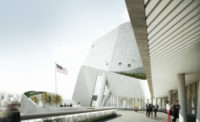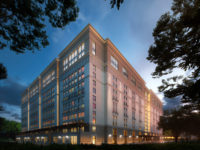Los Angeles to Welcome Wave of New Cultural Buildings

Los Angeles is about to get a spate of new cultural spaces, including one designed by Edwin Chan, who, after more than 25 years working with Frank Gehry (most recently as a design partner) left last year to start his own firm, EC3. One of Chan’s first post-Gehry projects is Chalet Hollywood, a kind of artists’ salon that is expected to open this fall and close after a year of operation.
Unlike the Guggenheim Bilbao, Gehry’s sprawling metal masterwork for which Chan was project designer, Chalet Hollywood is a small space outfitted mostly in wood, to suggest an alpine lodge, and reached through the back door of an existing gallery called LACE (Los Angeles Contemporary Exhibitions) on Hollywood Boulevard. Chan is collaborating with the artist Piero Golia on the new space, which will operate as a private members’ club, open at night. The project received a grant from Chicago’s Graham Foundation and will be, according to the foundation’s website, a descendent of Gertrude Stein’s Paris apartment and Andy Warhol’s Factory.
Also expected to open later this year fall is the Wallis Annenberg Center for the Performing Arts, a $70 million theater complex created out of the deco-Italianate Beverly Hills Post Office building. Architect Zoltan Pali of the firm SPF:architects has worked to create sleek new theater facilities while preserving the murals created for the 1934 post office by WPA artist Charles Kassler. Meanwhile, Pali is also working (with Renzo Piano) on a museum for the Academy of Motion Picture Arts and Sciences, which will turn the former May Company department store building on Wilshire Boulevard into a high-tech exhibition space (including a glass-globe theater to be named for David Geffen).
That museum is next door to the Los Angeles County Museum of Art, which is looking to build a twisty new complex by Peter Zumthor. And it is down the street from the old department store building that houses the privately owned Petersen Automotive Museum. It recently unveiled plans for a $20 million exterior renovation, by Kohn Pedersen Fox (KPF), which would cover the 1962 building in swoopy ribbons of stainless steel. Preservationists are alarmed that the original building by Welton Becket, creator of such icons as the Capitol Records building, will be obscured. “It's a shame,” says Brooke Hodge, a Los Angeles curator and critic. “The existing facade is so beautiful, with streamlined fins that seem to relate to the cars inside. This new wrapper will obscure all that and will probably look dated in no time.” (In a press release, Kohn stated that "while the 'bones' of the building work well for the display of cars, the expression of the structure lacks imagination.")
The same preservationists should be happy with plans for a new museum funded by the brothers who created Guess Jeans, to house their own collection of contemporary art. The brothers, Maurice and Paul Marciano, purchased the Scottish Rite Lodge, a long-vacant Masonic temple on Wilshire Boulevard; the building was designed by Millard Sheets, known for some 50 Home Savings Bank of America branches around southern California. The Marciano brothers have hired architect Kulapat Yantrasast of wHY Architecture to turn the building, festooned with travertine sculptures and mosaics on Masonic themes, into a gallery. “The architecturally significant elements on the exterior and interior will be maintained and restored,” says Yantrasast, who is already known in Los Angeles for several galleries, including one for L&M Arts in a former power plant in Venice, the other for Perry Rubenstein in Hollywood, and for his own board-formed concrete house in Venice.


